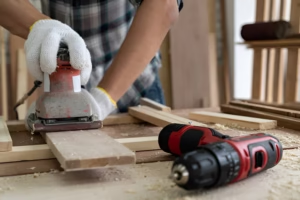Carpenter Insurance Explained for Small Business Owners
It takes more than skill to run a woodworking business; you also have to protect your company from risks you can’t predict. Carpenter insurance is important to protect your business from lawsuits, property loss, and other unplanned events. This complete guide will go over all the different parts of carpenter insurance, which will help small business owners make smart choices.
What Is Carpenter Insurance?
Carpenter insurance includes a variety of plans that are meant to keep carpenters and their businesses from losing money because of accidents, damage, or lawsuits. Getting the right insurance is important whether you’re a self-employed handyman or run a small team.
Key Components:
- Public Liability Insurance: Protects you from third-party claims of harm or property loss caused by your work.
- Employers’ Liability Insurance: If you have staff, you have to get this insurance. It covers claims from workers who get sick or hurt at work.
- Tools and Equipment Insurance: Keeps your tools and equipment safe from being lost, stolen, or damaged.
- Professional Indemnity Insurance: It pays for your lawyer fees if a client says your services or advice cost them money.
- Personal Accident Insurance: If you get hurt and can’t work, this insurance will pay you.

Why Do Carpenters Need Insurance?
When you work as a builder, you use dangerous tools, machines, and materials that can hurt you and other people. If you don’t have insurance, you could be responsible for the costs of repairs or court fees if something goes wrong.
Common Risks:
- Injuries to Clients or Third Parties: When workers get hurt on the job by accident, it can be very expensive to file a lawsuit.
- Property Damage: Damage to a client’s property can happen because of mistakes or accidents.
- Tool Theft or Damage: Tools are important for your job, and if you lose them, your business can’t run.
- Legal Disputes: Clients may say they are unhappy with your work, which could lead to court battles.
Types of Carpenter Insurance Policies
1. Public Liability Insurance
For builders, this is one of the most important rules. It covers the costs of going to court and getting paid if your work hurts someone or damages their property. This insurance would pay for things like medical bills and lost wages if a customer trips over your tools and gets hurt.
2. Employers’ Liability Insurance
In many places, you are required by law to have this insurance if you have employees. This insurance covers claims from workers who get hurt or sick at work. (Protectivity)
3. Tools and Equipment Insurance
It keeps your tools and equipment safe from being lost, stolen, or damaged. Because woodworking requires specialized tools, this coverage makes sure you can repair important things without having to spend a lot of money.
4. Professional Indemnity Insurance
It pays for your legal fees if a client says your professional services or advice cost them money. This is especially important if you offer design or consulting services.
5. Personal Accident Insurance
If you get hurt and can’t work, this insurance will pay you. It can pay for your medical bills and lost wages while you’re healing.

Carpenter vs Electrician: Understanding the Insurance Needs
Even though this guide is mostly about carpenter insurance, it’s still helpful to know how it differs from other trades’ insurance needs, like electricians’, in the discussion about whether to be a carpenter vs electrician. Both jobs come with their risks and need specific insurance plans. Carpenters are more likely to get hurt by their tools and damage property during setups. At the same time, electricians have to deal with more electricity dangers and tighter safety rules. Because of this, electricians may choose liability and workers’ compensation insurance with more benefits. Knowing these differences helps builders figure out what kind of insurance they need and how to get it.
Cost of Carpenter Insurance
The cost of carpenter insurance depends on things like the number of workers you have, the size of your business, the value of your tools, and the risks that come with your job. Most of the time, carpenters can expect to get paid:
- Public Liability Insurance: Starting from £6.30 per month.
- Employers’ Liability Insurance: Prices vary, so it’s important to get a price that fits your needs.
- Tools and Equipment Insurance: Rates are based on how much your tools are worth.
To get the best coverage at the best price, it’s smart to get quotes from more than one insurance company.
How to Choose the Right Carpenter Insurance
- Assess Your Risks: Think about the specific risks that come with your job, like the projects you work on and the places where you do your work.
- Determine Necessary Coverage: Based on your risk estimate, choose the business insurance plans that are most important to you.
- Compare Quotes: To get multiple quotes and find the best deal, use comparison websites or talk to insurance agents.
- Check Policy Details: Make sure you know what each insurance covers and what it doesn’t cover.
- Review Regularly: Check your insurance coverage often to make sure it’s still enough as your business grows or changes.
Conclusion
Small business owners in the Woodfield need to get insurance for their workers. It protects your business’s finances against a number of risks, ensuring its long-term success and growth. You can protect your income by getting the right insurance plans if you know about the different types of coverage and figure out what you need. (admiralbusiness.com).
FAQs
Does home insurance cover harm from carpenter ants?
Most homeowner’s insurance doesn’t cover carpenter ant damage. Most rules consider it upkeep, not a sudden incident. Housekeeping should prevent pests. You should check your policy or contact your insurer for particular advantages.
How much is insurance for a carpenter?
Carpenters pay $500–$1,500 per year for general liability insurance. Location company size services and coverage restrictions affect pricing. Tools workers’ compensation and business car insurance may raise costs.
Does insurance cover carpenter ant damage?
Carpenter ant damage is avoidable; thus, most homes insurance doesn’t cover it. Regular inspections and pest management are necessary since termites and carpenter ants are usually excluded from insurance.
What Insurance Does a Carpenter Need?
A carpenter typically needs the following types of insurance:
- General Liability Insurance – Protects third-party property and injury.
- Tools and Equipment Insurance – Tool theft, loss, and damage protection.
- Workers’ Compensation Insurance – Required for businesses with workers; covers job-related injury, medical expenses, and lost income.
- Commercial Auto Insurance – For cars that are used for business.
- Professional Liability Insurance – Includes claims of carelessness or mistakes in your work.
- Contractor’s All-Risk Insurance – Includes items on-site and work that is still being done.